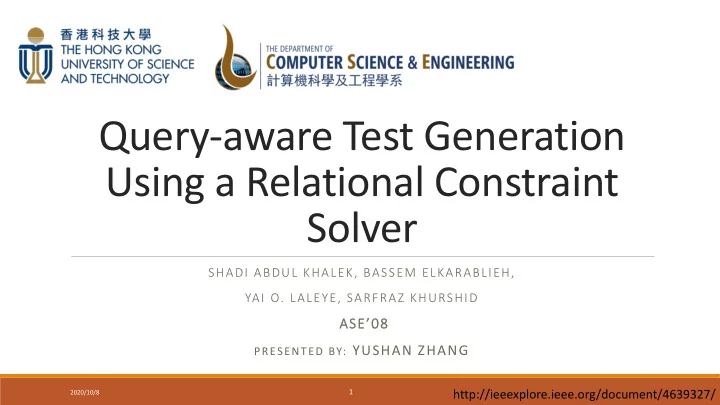

Query-aware Test Generation Using a Relational Constraint Solver SHADI ABDUL KHALEK, BASSEM ELKARABLIEH, YAI O. LALEYE, SARFRAZ KHURSHID ASE’08 PRESENTED BY: YUSHAN ZHANG 1 http://ieeexplore.ieee.org/document/4639327/ 2020/10/8
Blackbox DBMS Testing Query DBMS Results 2 2020/10/8
Automat DBMS Testing Requires the generation of: 1. Test queries for a given database schema 2. A set of test databases 3. Oracles to verify the result of query execution 3 2020/10/8
Reality…manual work The developers will create the regression tests (regular) by: 1. Generating the databases 2. Writing queries 3. Running the queries and compare it to the ground truth (oracle) If there is a bug: 1. Add crash-triggering queries 2. Add the correct results for the queries (oracle) 3. Add the databases 4 2020/10/8
Oracle…? There are 1000 randomly generated rows in the table. What is the correct #row returned? SELECT DISTINCT id FROM student WHERE (id=1 OR (id>=3 AND id<=5)); Easy! At most 4! 5 2020/10/8
Oracle…? There are 10000 randomly generated rows in the table. What is the correct #row returned? SELECT DISTINCT id FROM student WHERE (id=1 OR (id>=3 AND id<=5)); WHERE id > 200; Could you still tell the correct number? 6 2020/10/8
Generating data with oracle? Given the schema for a database D and a query Q : SELECT DISTINCT id FROM student WHERE (id=1 OR (id>=3 AND id<=5)); The tool generates: 1. Data to fill the table 2. Oracle to verify the result Data is the oracle! QUERY-AWARE generation! 7 2020/10/8
ADUSA Overview => Solve the constraints => Insert the instances => Check for consistency 8 2020/10/8
SQL => Alloy Leverage the Alloy specification language for the transformation: The query: SELECT DISTINCT id FROM student WHERE (id=1 OR (id>=3 AND id<=5)); Becomes: The Alloy Analyzer solves the constraints and generates instances 9 2020/10/8
Alloy => SQL Alloy returns the following instances: Transformed into SQL insertions: 10 2020/10/8
ADUSA Overview => Solve the constraints => Insert the instances => Verify the result 11 2020/10/8
Experiments 1. With Oracle 11g (commercial) ◦ Verify the correctness of ADUSA 2. With MySQL (open source, multi-platform) ◦ Test ability in reproducing bugs 3. With HSQLDB (open source) ◦ Test ability to detect injected bugs 12 2020/10/8
Database Schema and Queries 13 2020/10/8
Experiment with Oracle 11g Scope : #varchar values 14 2020/10/8
Experiment with MySQL Reproduce Bug 13371 in MySQL 4.0; Scope for int is 4. 253 /826 counter examples (databases), < 10s 15 2020/10/8
Experiment with HSQLDB 1. Run the query with ADUSA => 1108 instances, < 10s 2. Modify the source code to retrieve partial data => fault injection 3. Use ADUSA to verify the execution => use the generated instances 499 /1108 counter examples. 16 2020/10/8
Summary • Automatic DBMS testing need the generation of the query, database and oracle. • ADUSA generates the database which is also the oracle. • It translates SQL <=> Alloy • It uses Alloy analyzer to solve the constraints • It executes the SQL and checks for inconsistency 17 2020/10/8
Reflections 1. Gives a good insight to solve the oracle problem: ‘should - exist’ result 2. SQL <=> Alloy translation is hard to extend, mainly involves manual work 3. How to retrieve the queries? ◦ Translates the SQL grammar and enumerate [the author’s later work] ◦ Random generation [arxiv’20, ETH Zurich] 18 2020/10/8
Recommend
More recommend